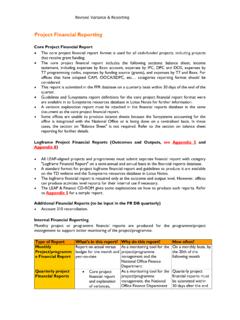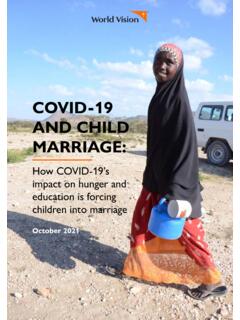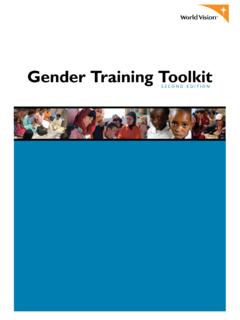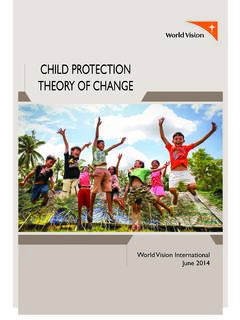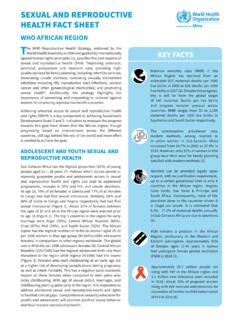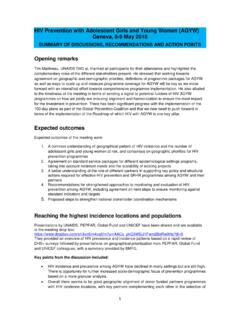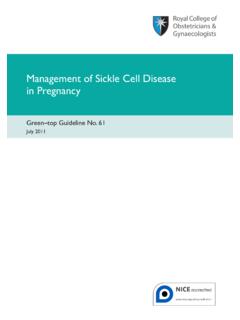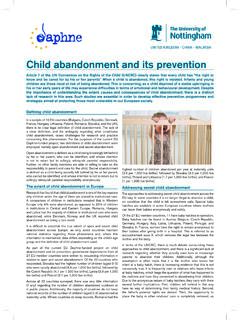Transcription of GUIDE TO MATERNAL, NEWBORN AND CHILD HEALTH AND …
1 GUIDE TO MATERNAL, NEWBORN AND CHILD HEALTH AND NUTRITION IN EMERGENCIESGUIDE TO MATERNAL, NEWBORN AND CHILD HEALTH AND NUTRITION IN EMERGENCIES World Vision International 2012 ISBN 978-0-918261-26-7 Author: Rena Geibel, MPH, CD (DONA)All rights reserved. No portion of this publication may be reproduced in any form, except for brief excerpts in reviews, without prior permission of the by Global HEALTH and WASH on behalf of World Vision InternationalFor further information about this publication or World Vision International publications, or for additional copies of this publication, please contact Vision International would appreciate receiving details of any use made of this material in training, research or programme design, implementation or Editor: Marina Mafani. Production Management: Katie Klopman, Ann Abraham. Copyediting: Nancy Warren. Proofreading: Audrey Dorsch . Cover Design and Interior Layout: Dan Irwin, Siefert Irwin, Inc. Cover photo World Vision/ Kenneth KibetCover photo: Mothers hold their babies during a distribution of mosquito nets in Summary In 2007, World Vision (WV) initiated a process of prioritising low-cost, evidence-based, measurable and preventive interventions in order to combat the primary causes of maternal and CHILD mortality.
2 The HEALTH and nutrition (H/N) Do, Assure, Don t Do (DADD) guidelines helped to orientate effort and resources towards a strategic focus. This focus is primarily influenced by The Lancet study on CHILD survival and is further shaped by existing human rights approaches, the right to survival, and the right to HEALTH treatment and care. WV s development and phased implementation of the 7-11 approach1 (2010) is part of the process to strengthen expertise and competencies in key MNCH and nutrition interventions that fit with our organisational strategy and mandate. Strategic training on 7-11 interventions, building partnerships and recruiting experienced field HEALTH staff are part of WV s investment towards more consistent maternal, NEWBORN and CHILD HEALTH (MNCH) and nutrition emergencies, our commitment continues as we strive to save the lives of young children and mothers by focusing emergency response resources where they are critically needed. The 7-11 approaches are implemented where feasible, and in a phased manner.
3 Some services that need to be met in an emergency cannot be provided by WV, as they are outside our remit, expertise and mandate. In such situations, it is our role to advocate for other agencies to complement the WV response and fill the gap. The 2011 HEALTH Nutrition and HIV DADDs2 in large-scale emergencies, along with this GUIDE to MNCH in emergencies, enable staff to implement more consistent MNCH and nutrition interventions, which are proven to save lives. This GUIDE is WV s first attempt to provide additional guidance at operational and technical levels on what steps are necessary for preparedness and rapid response. Humanitarian principles and core operating standards support the achievement of technical minimal standards in humanitarian situations. Therefore, operational recommendationsinclude the following:1. Communication Develop an information-management strategy for internal and external stakeholders. Communication on the emergency situation with current and potential donors is vital to ensure that HEALTH services are accessible and offered free at the point of service delivery to the affected population for the duration of the Accountability Provide information, consult with communities, promote community participation, and collect and act on feedback and complaints to maintain transparency and accountability during emergency responses.
4 3. Coordination Building and pre-positioning partnerships at the national level with other agencies implementing MNCH and nutrition can foster rapid responses during an emergency. During an emergency response, a designated staff member should attend H/N (and other relevant sector/cluster) coordination meetings and represent WV in these discussions, at both the national and sub-national levels. This person is vital in sharing WV s work and planning for joint assessments and operations, and in informing our staff on interagency developments, protocols, reporting requirements, Supplies Pre-positioning supplies, such as clean delivery kits, oral rehydration solution (ORS), cholera treatment kits, hygiene kits and materials for thermal protection in cold climates, should be Staff competencies Programme managers need to take stock of potential risks and human resources available to respond to MNCH and nutrition as well as related sectors such as food security and nutrition, water, sanitation and hygiene (WASH) and protection, since limited technical staff in development often hampers our immediate relief response.
5 A variety of key training can be offered in non-emergency times to improve the emergency response capacity of Information management Responses will be effective only if the process of assessment, monitoring and reassessment is used in each humanitarian context. A time frame for the completion of the response plan(s) should be agreed between the response manager(s) and national director, and shared with appropriate partnership stakeholders. Response plans will evolve over time as assessment and information increase and context changes. 1 World Vision International (2010). 7-11 Start-up Field GUIDE . $file/ World Vision International (2011). Working in maternal and CHILD HEALTH , nutrition, HIV and AIDS, and water, sanitation and hygiene. Available on (log-in required). GUIDE TO MATERNAL, NEWBORN AND CHILD HEALTH AND NUTRITION IN EMERGENCIES1 This GUIDE represents core activities along the continuum of care (life-cycle approach) for reproductive HEALTH issues, pregnancy, childbirth, maternal and NEWBORN HEALTH and CHILD HEALTH , which will save lives.
6 WV resources and models, along with interagency protocols and guidelines, are referenced to support the implementation of the key technical actions, some of which are listed below:1. 7-11 strategy World Vision aims to have elements of the 7-11 strategy in place and prioritised according to the emergency context. In the start-up phase of an emergency, WV strives to implement the 7-11 strategy in an appropriate, resourced and phased manner. Initial action should start with priority interventions that address the causes of excess mortality ( measles vaccination) and in a phased manner introduce additional services, as the situation becomes more Referrals Technical staff should strive to determine who offers clinical services and how to refer clients to these services, as World Vision typically does not offer clinical Wider HEALTH system improvements Where WV operates HEALTH clinics, ensure these do not function in isolation from wider HEALTH system Sexually transmitted infections (STI)/Human immuno-deficiancy virus (HIV) While World Vision emphasises abstinence outside of marriage and fidelity within marriage, we recognise that consistent and correct use of condoms prevents HIV infection.
7 We recommend correct and consistent use of condoms for harm reduction, and this should be done as an integrated programme approach rather than a stand-alone intervention. In some emergency settings, it may be appropriate to make condoms available in hygiene kits, along with providing sensitisation and information regarding proper use and Sexual and gender-based violence (SGBV) While WV does not provide clinical HEALTH services for victims of rape, staff can provide immediate psychosocial support (psychosocial first aid); raise awareness among communities on prevention, reporting and available services; and assure effective referrals to appropriate clinical services. 6. Family planning (FP) Post-rape kits, which include post-exposure prophylaxis (PEP) and emergency contraception , should be accessible in an emergency. Experience shows that women want to continue their contraceptive method during emergencies. Basic contraception , including condoms, should be available from the onset of the crisis to meet demands of continued family-planning methods of choice.
8 These methods should not require comprehensive medical procedures or follow-up. 7. Pregnancy Emergency responses generally may not provide focused antenatal care (ANC) until the humanitarian situation stabilises. World Vision can establish communication messages on the importance of childbirth by skilled birth attendants (SBAs) and referral procedures for emergency obstetric cases. Food security programming, community-based management of acute malnutrition (CMAM), or distribution of food aid can be an opportunity to provide this information and promote maternal, neonatal and CHILD HEALTH beneficial practices and services. Where delivery by an SBA is not accessible, clean delivery kits should be distributed to visibly pregnant women, along with registration of these women for maternal and NEWBORN care visits and postpartum services. 8. Childbirth Primary HEALTH -care facilities need SBAs, neonatal resuscitation and basic emergency obstetric and NEWBORN care (BEmONC) in order to prevent maternal and NEWBORN mortality and morbidity.
9 If women are not able to access a HEALTH -care facility, WV can distribute clean delivery kits to visibly pregnant women. WV also works with the community to establish a referral system for obstetric and NEWBORN complications. Traditional birth attendants (TBAs) should be mobilised to be part of this referral system and promote NEWBORN care (thermal care, benefits of colostrum and early initiation of breast-feeding) but should not be equipped or trained to perform deliveries. 9. Maternal and NEWBORN care World Vision plays an important role in educating the community on NEWBORN care and the benefits of seeking skilled support for childbirth and NEWBORN care. Through the registration of households with newborns, children under 24 months and breast-feeding/pregnant mothers, essential NEWBORN and maternal care and food assistance can be planned and TO MATERNAL, NEWBORN AND CHILD HEALTH AND NUTRITION IN EMERGENCIES210. Nutrition World Vision emphasises proactive activities to maintain and improve nutrition and growth at the community and HEALTH -facility level, which includes exclusive breast-feeding for six months; adequate complementary feeding with breast-feeding for two years; adequate intake of vitamin A, iron and iodine; and appropriate nutritional care of sick and severely undernourished.
10 Breast-feeding World HEALTH Organization (WHO) evidence shows that infant deaths can be averted through effective breast-feeding. Promoting immediate and exclusive breast-feeding must be done in all humanitarian settings. While women in emergencies undergo stresses and nutrition deprivation that may affect breast milk supply, this is usually temporary. Breast-feeding can be continued and even restarted (relactation) with proper education and support, such as women- and infant-friendly spaces (WAIFS). For those women who meet criteria for breast-milk substitutes (BMS) and have done so prior to the onset of the emergency, BMS should be provided in ways that follow the International Code3 and WV milk policy. B . As part of emergency preparedness, WV should ensure that staff have competencies to screen for and manage acute malnutrition, and in infant and young CHILD feeding (IYCF) counselling and specific emergency response approaches, such as integrating IYCF into CMAM. C . In situations where the nutritional needs of the general population are not met, WV advocates for a general ration to be distributed, which is appropriate in quantity and quality for young children s complementary food needs and for the specific needs of pregnant and lactating women (PLW).

